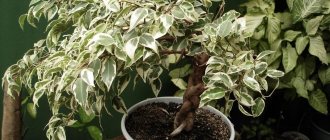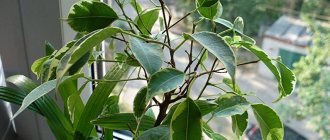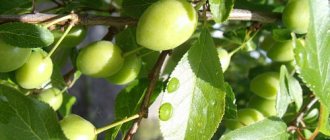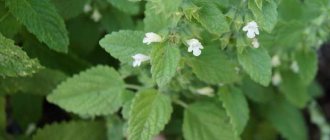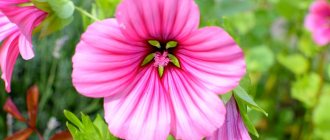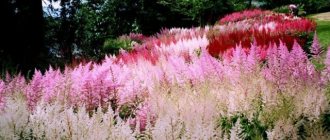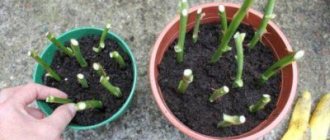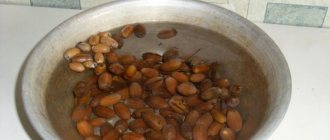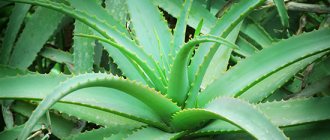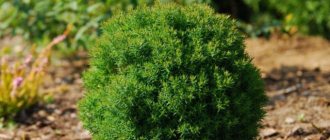What does ficus Ginseng look like?
Ficus Ginseng, also known as Ficus Ginseng or Microcarpa, belongs to the Mulberry family. The plant is presented in the form of an evergreen tree that reaches a height of 25 meters. Distinctive features of the culture are a spreading bright green crown, a powerful and thick trunk, and hanging aerial roots.
Ficus Ginseng in a pot
Common varieties
In the field of indoor floriculture, the following varieties of ficus are most common:
- ficus rubbery;
- ficus lyreform;
- ficus dwarf;
- Ficus Mountain.
Important! Many gardeners grow ficus auricularis and bengal in their summer cottages.
Medicinal properties
In addition to its beautiful appearance, the culture is known for its medicinal properties. The leaves of the inflorescence are used to treat benign tumors and skin diseases. Decoctions based on the bark or foliage of the tree also help to cope with diseases of the stomach and lungs.
History of appearance
Ficus Microcarpa came to Russia from Indonesia and Taiwan. The best eastern breeders worked on its breeding. The plant is considered predominantly tropical and subtropical. However, due to its ease of care, the tree began to be grown in many corners of the Earth, including Russia.
Beneficial features
The healing properties of ficus microcarpa were known even before it became a houseplant. Its juice, leaves and bark were used to create ointments and decoctions.
Ginseng is most effective as an assistant in the fight against malignant tumors. Tea made from the leaves of this plant will not cure cancer, but may help prevent the disease.
Tincture from the roots of ficus microcarpa is recommended to be taken during the treatment of fibroids and fibroids that affect the uterus. The juice makes a good ointment that speeds up the healing of wounds and bruises.
Lotions from boiled ficus leaves are applied to treat arthritis, radiculitis, and osteochondrosis. It is also recommended to apply a similar mixture to hair if it falls out and splits.
Ficus Microcarpa Ginseng - home care
In order for a tree to grow and not be subject to the development of diseases, it is necessary to provide it with decent growing conditions. All rules are presented below. If you don’t follow them, the ficus will grow, but you shouldn’t expect much decorativeness from it.
Temperature and lighting
Ficus Melanie - home care
Ficus Ginseng is considered a heat-loving crop. therefore, growing it in the north of the country will be problematic. In summer, the optimal temperature for plant growth is considered to be from +18 to +25 degrees Celsius. In winter, the minimum threshold for the development of culture is at least +15 degrees.
The plant adapts to natural and artificial light. For the ficus to fully develop, moderate light is necessary, otherwise the leaves can be scorched. Gardeners recommend placing a pot with a tree in the western part of the house, where there is partial shade.
Attention! If the plant is regularly exposed to direct sunlight, its leaves may fall off.
Watering and spraying
The tree loves moderate watering. In winter, ficus Ginseng needs to be watered no more than once a week. With a greater flow of water, its root system may begin to rot.
In summer, the frequency of procedures is increased to 2-3 times a week. It is worth remembering that the crop needs to be watered with warm filtered water.
Due to the fact that the crop grows naturally in tropical countries, its foliage needs constant moisture. In Russia, it can be done artificially by spraying ficus leaves with plain water through a spray bottle. The procedure is carried out every day, they try to do it in the evening.
Ficus Ginseng loves moderate humidity, so its indoor level should be above 60%.
Soil and fertilizing
The plant develops well in fertile soil supplied with organic fertilizers. It is recommended to equip the soil 2-3 times a month with coarse sand, peat mixture, and wood ash.
The tree needs to be actively fertilized in the summer, during the flowering period. Fertilizing is applied 2-3 times a month. Gardeners can alternate the application of organic fertilizers with mineral ones.
Features of winter care
The difference in care in winter is only to reduce watering procedures and fertilizing by 2 times. During cold weather, the plant also does not need to be pruned.
Considering that the plant is mainly grown in pots, there is no need to protect it from the cold. If the container with the ficus was taken out into the garden, then at the beginning of autumn it is simply brought into the house.
Advice from experienced
In new conditions, the ficus experiences quite a lot of stress, so you should know the following aspects of caring for a new flower:
- the ficus "Ginseng" tolerates movement extremely negatively, so it must be immediately placed in a permanent habitat and not moved anywhere in the future;
- the plant does not like wind and strong drafts;
- ficus reacts poorly to direct ultraviolet rays and excessively dry air - try to choose a site for it so as to provide acceptable living conditions; the flower pot should be located away from radiators and other heat sources in the house; it is optimal to place it on the windows on the west, north-west or north side; if the plant you have chosen has a variegated shape, then it will need more light - it makes sense to place such a ficus on southern or southeastern windows;
- in the first days after purchasing a plant, it is important to ensure an optimal level of humidity in the chosen place - to do this, the pot must be placed in a small tray with moistened pebbles;
- You should spray the leaves every day with a spray bottle and, if possible, turn on a humidifier or at least an indoor fountain for 2–3 hours a day.
When and how does it bloom
At home, ficus Ginseng color is infrequent. Even less often, fruits appear on its branches. This occurs due to artificial growing conditions. For full flowering, the ficus needs to be pollinated by wasps.
- Types of flowers
Ficus Moklame - home care
Ficus flowers are small in size. They grow in small scatterings on the branches of plant crops. A little later, the flowers turn into fruits (syconia), which are similar in appearance to large berries.
- Flower shapes
The inflorescences have a round shape with a spherical receptacle.
- Flowering period
The active growing season of the crop falls in late spring.
Important! You can see small flowers on the branches from May to August.
- Changes in care during the flowering period
Caring for the Ginseng ficus at home during flowering changes slightly. In summer and spring, the plant needs to be watered more actively - up to 3 times a week. In addition, you will need to loosen the soil for better oxygen supply to the roots and prune dried shoots.
Keeping fit
After purchasing a ficus microcarpa that has already been formed as a bonsai, you need to constantly monitor its shape. Stores use special products called retardants. They slow down the growth of the plant and prevent it from stretching upward. With the end of their action, growth will resume - the leaves will become larger, the branches will stretch upward. If there is a lack of nutrients, the ficus will begin to consume the reserves deposited in the fleshy roots. This will lead to a decrease in their size and compression.
To ensure that ficus microcarpa retains its original appearance, shoots and roots are regularly pruned. Pruning is carried out only in summer! All regrown branches are cut off, leaving 2 pairs of leaves on them. This is a creative process. You need to focus not only on pruning technology, but also on the overall appearance of the plant. First of all, those shoots that violate the desired shape are cut off. Use a sharp tool for cutting!
Berry "FAIRY GATHERING"
Buy now at a discount and get your first harvest in 3 weeks. Enjoy fresh and delicious strawberries all year round!
Buy at a discount
How does Ficus Ginseng propagate?
Ficus Ginseng propagates in several ways: by germination of seed material, cuttings, and air layering.
Culture propagation
- Germination of seeds
In this case, the crop seeds are sprinkled with a peat mixture with a small amount of sphagnum, after which they are covered with film. The seed material is watered until the first shoots appear, and then transplanted into a pot.
- Rooting cuttings
In the spring, a branch up to 15 cm long is cut from an adult plant, placed in warm water for a couple of hours, and then planted in a container with soil mixed with a peat mixture. The plant crop is covered with film and watered 1-2 times a week. When the first leaves appear on the branches, the Ginseng ficus is transplanted into a larger container.
- Air layering
In this case, the bark is cut in a circle from the tree trunk. The bare areas are covered with sphagnum, and a film is laid on top. The resulting structure is constantly moistened. After some time, new shoots will appear at the cut sites, which can be cut off and transplanted into a separate container.
- Other options
Sometimes gardeners propagate the crop by root cuttings. The step-by-step process is similar to conventional cuttings, however, the cut shoot is planted at a deeper distance, covered entirely, and the soil itself is mixed with peat and sand. Next, the sprout is cared for according to the scheme described above.
Transfer
Ficus Ginseng is considered a young plant up to 5 years of age, so during this time it must be replanted every year with a complete replacement of the soil. An adult plant needs a new pot every 2-3 years, in which a new substrate is added to the old soil. Expanded clay is poured into an even layer at the bottom of the pot, and the top of the soil is sprinkled with sand.
For your information! For this procedure, purchased soil for ficus plants or one made independently by a gardener is suitable.
Options for homemade soil for transplanting microcarps:
- leaf soil, peat soil, turf soil and sand in equal proportions;
- sand, clay granules and picking soil in equal quantities;
- turf soil, peat soil, sand with the addition of charcoal in a ratio of 2:1:1.
Possible problems in cultivation and diseases
Despite the fact that ficus Ginseng is considered an unpretentious crop, gardeners may encounter some problems in the process of growing it. For example, with pale and dry leaves, dropping buds, and the appearance of pests.
- Drops buds and leaves
If foliage and flowers begin to fall from tree branches, this may indicate a sudden change in temperature or excessive lighting. To get rid of the problem, you need to move the ficus to the shadow side.
- The leaves are turning pale
A change in foliage color indicates that the plant is oversaturated with moisture. Pallor can also develop due to a lack of minerals.
- The tips of the leaves are drying out
Dry leaves can be indicated by low humidity in the room, as well as lack of timely spraying. A similar symptom also occurs when there is an oversaturation of mineral components.
- The lower leaves fall off
Falling leaves indicate that the plant is oversaturated with moisture, as well as a lack of fertilizing.
Dry tips of ficus leaves
Pests
During the flowering period, the crop is often attacked by aphids and spider mites. Insects appear on the branches of a tree when its immunity decreases. This can occur when there is a sudden change in indoor temperature. If the owner of a ficus notices parasites, the plant should be immediately treated with chemical insecticides, following the instructions on the package.
Gardeners may encounter problems such as rotting leaves, the appearance of spots and white spots on them, slow growth, and lack of flowering. All this indicates unfavorable growing conditions, lack of moisture, mineral components, untimely pruning and replanting.
Signs and superstitions
Many peoples treat ficus trees differently. The Chinese consider this plant a symbol of a strong family. In many Chinese cities, newlyweds are given this tree for their wedding for family well-being. In Thailand, ficus is considered a healing and magical inflorescence that helps cleanse a person’s aura and save him from many diseases. But on the territory of Russia, many are convinced that this culture is characterized by negative energy and attracts misfortunes to the houses where it grows.
Various superstitions are associated with the plant
Important! Many Slavs believe that ficus plants standing in pots at home have a negative effect on the love relationships of men and women.
Ficus Ginseng is an evergreen plant that is characterized by strong immunity and vitality. Despite the fact that the crop is subtropical, it is actively grown artificially in countries with temperate climates. In order for the crop to begin to bloom in the spring-summer period, it is necessary to water it in a timely manner, feed it and transplant it into larger containers.

